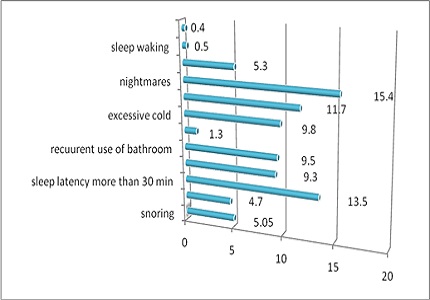Impact of media on sleep quality of adolescents
Abstract
Introduction: Sleep disturbanceis an important risk factor for the development of depression during adolescence. Excessive electronic media usage at night was a risk factor for adolescents’ sleep disturbance. As late sleep onset can reduce sleep, this sleep/circadian rhythm disturbance may cause brain impairment [1]. We planned to identify sleep quality of school going adolescents as well as predictors on disturbed sleep patterns like Television, Mobile.
Methods: A community based cross-sectional analytical study compromising of1000 school going adolescents between 8th to 12th standard studying in government and private schools of city of Gwalior for duration 1 year. Questionnaire prepared on Pittsburg Sleep Quality Index guidelines were distributed to them.
Results: In our study the most common cause for sleepdisturbancesamong adolescentswere nightmares(15.4%) followed by sleep latency more than 30 minutes. Prevalence of poor sleep quality (PQSI score>5) was more in 15-17 years age adolescents, class standard 11th and 12th and lower economic status. The mean time of sleeping was 7.1±.67 hours on weekdays and 7.42±0.35 hours on weekends. Increasing usage of mobile internate was found to be singnificantly associated with poor sleep quality in comparison to television watching. Poor sleep has direct corelation with scholastic performance.
Conclusion: About one third of the adolescent’s population was having poor quality sleep. Increasing use of mobile internate was found to be singnificantly associated with poor sleep quality Poor sleep has direct corelation with scolastic performance. Sleep assessment must be included in the overall assessment of child’s well-being.
Downloads
References
2. Luiz Antonio Del Ciampo, Leda Regina Lopes Del Ciampo, Adolescence and Sleep, Journal of Community and Public Health Nursing , Volume 2 - Issue 3.
3. Buysse DJ, Reynolds CF 3rd, Monk TH, Berman SR, Kupfer DJ. The PittsburghSleepQualityIndex: a newinstrument for psychiatric practice and research. Psychiatry Res. 1989 May;28(2):193-213. [PubMed]
4. National Sleep Foundation. 2006. National Survey on the Sleep Patterns Of United States Adolescents. Sleep in Americans poll highlights key findings [on-line] [20 Jun 2006]:
5. Shengui Li,Xinming Jin, MD1; Shenghu Wu et al, The impact of media use on sleep patterns and sleep disorders among school aged children in CHINA. Sleep Vol. 30,No,3,2007.
6. Gabrielsen HR. Insomnia and its predictors in transition from adolescence to adult hood [Serial online].2009 [Cited2010 may 05]; Available from: URL: https://bora.uib.no/bitstream/1956/3500/ 1/55609437.pdf
7. Text messaging on mobile phones affecting quality of sleep. Latest news and reviews [Serial online]. 2009 September 09[Cited 2010 May 03]; Available from: URL:http://news-reviews.org/uncategorized/text-messaging-affect-quality-of-sleep/
8. Van den Bulck J. Televisionviewing, computer gameplaying, and Internet use and self-reportedtime to bed and timeout of bed in secondary-schoolchildren. Sleep. 2004 Feb 1;27(1):101-40
9. Higuchi S, Motohashi Y, Liu Y, Maeda A. Effects of playing a computer game using a brightdisplay on presleepphysiologicalvariables, sleep latency, slow wave sleep and REM sleep. J Sleep Res. 2005 Sep;14(3):267-73.
10. Chen X, Sekine M, Hamanishi S, Wang H, Gaina A, Yamagami T, Kagamimori S. Lifestyles and health-related quality of life in Japaneseschoolchildren: a cross-sectional
study. Prev Med. 2005 Jun;40(6):668-78. [PubMed]
11. Kubota T, Uchiyama M, Suzuki H, Shibui K, Kim K, Tan X, Tagaya H, Okawa M, Inoue S. Effects of nocturnalbrightlight on salivamelatonin, corebody temperature and sleeppropensityrhythms in human subjects. Neurosci Res. 2002 Feb;42(2):115-22. [PubMed]
12. Higuchi S, Motohashi Y, Liu Y, Ahara M, Kaneko Y. Effects of VDTtasks with a brightdisplay at night on melatonin, coretemperature, heart rate, and sleepiness. J Appl Physiol (1985). 2003 May;94(5):1773-6. Epub 2003 Jan 17. [PubMed]
13. Higuchi S, Motohashi Y, Maeda T, Ishibashi K. Relationship between individual difference in melatonin suppression by light and habitual bedtime. J Physiol Anthropol Appl Human Sci 2005;24:419-23.
14. Owens J, Maxim R, McGuinn M, Nobile C, Msall M, Alario A. Television-viewinghabits and sleep disturbance in schoolchildren. Pediatrics. 1999 Sep;104(3):e27. [PubMed]
15. Tazawa Y, Okada K. Physicalsignsassociated with excessivetelevision-gameplaying and sleep deprivation. Pediatr Int. 2001 Dec;43(6):647-50. [PubMed]
16. Olds T, Ridley K, Dollman J. Screenieboppers and extreme screenies: the place of screen time in the time budgets of 10-13 year-old Australian children. Aust N Z J Public Health. 2006 Apr;30(2):137-42. [PubMed]
17. Paavonen EJ, Pennonen M, Roine M, Valkonen S, Lahikainen AR. TV exposure associated with sleep disturbances in 5- to 6-year-old children. J Sleep Res. 2006 Jun;15(2):154-61. [PubMed]

Copyright (c) 2017 Author (s). Published by Siddharth Health Research and Social Welfare Society

This work is licensed under a Creative Commons Attribution 4.0 International License.


 OAI - Open Archives Initiative
OAI - Open Archives Initiative


